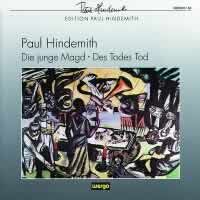Apparently it was only after he finished his one-act opera „Mörder, Hoffnung der Frauen” (Murder, Hope of Women) Op. 12 (text by Oskar Kokoschka) that Hindemith hit on the plan for a triptych consisting of that work and two others. The one-act opera “Das Nusch-Nuschi” Op. 20 (text by Franz Blei), the second work in this series, was not completed until a year after “Murder, Hope of Women”; Hindemith finished the second opera on 14 August 1920. In contrast “Sancta Susanna” Op. 21 (text by August Stramm) was already finished on 5 February 1921. Hindemith probably discovered the texts by Blei and Stamm simultaneously, and immediately recognized the possibility of extending and continuing the theme of “Murder, Hope of Women” with these two other pieces. It was thus that a triptych of one-act operas closely connected in their thematic content came into being. The three works deal with the same subjects from three fundamentally different points of view. The general themes include sexuality, culture, punishment, violence, and transfiguration.
On one hand in his setting of this three pieces Hindemith concentrated directly on the texts and sought in his music an equivalent for the subject. “Murder, Hope of Women” he treated as a sonata form, “Das Nusch-Nuschi” as a lose series of relatively self-contained sections of which some recur in the manner of a Rondo, while “Sancta Susanna” is given a variation form. All the special characteristics of the three operas are nevertheless composed with reference to each other. If they are separated, and each piece is taken as an absolute, misunderstandings necessarily arise concerning Hindemith’s meaning.
“Das Nusch-Nuschi” represents in the context of the triptych a high-spirited burlesque; in his music Hindemith not only depicted the witty, obscene, and parodistic moments present already in the text, but also intensified them. In this way he created a score as drastic as it is rich in allusions; in which at any moment suggestions, associations, or references may become concrete through literal quotation. It is music about modern music at the turn of the century, in which Hindemith even parodies particular stylistic aspects he himself utilized in “Murder, Hope of Woman”. Hindemith quotes directly from the source work of musical Modernism, Wagner’s “Tristan and Isolde”, and this quotation, which occurs in the Kaiser’s words “Where now honor and true kind…”, is immediately followed by a quotation of the main theme from Richard Strauss’s “Till Eulenspiegel”.
“Das Nusch-Nuschi” is Hindemith’s most virtuoso orchestral score. The virtuosity and masterful artistic refinement of the score is all the more disturbing, even disruptive and irritating, because here Hindemith is setting a frivolous, light-weight text as a parody. The premiere of “Das Nusch-Nuschi” in Stuttgart on 3 July 1921, under the direction of Fritz Busch with décor by Oskar Schlemmer, was reviewed by the press with fierce hatred and a revealing aggressivity that even under these circumstances was perhaps not to be expected. Certain critics on this occasion in 1921 already anticipated the language of German art criticism that appeared after 1933. In the 1920s “Das Nusch-Nuschi” was also performed in Frankfurt, Prague (conducted by Alexander Zemlinsky), Essen, and Berlin; in the 1930s only in Antwerp. Since the Second World War the work has had only one staging which took place in Darmstadt in 1969.



